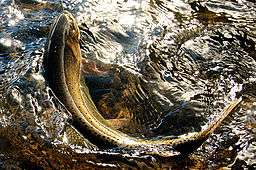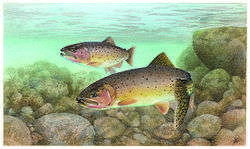Bonneville cutthroat trout
The Bonneville cutthroat trout (Oncorhynchus clarkii utah) is a subspecies of cutthroat trout native to tributaries of the Great Salt Lake, U.S.A. Most of the fish's current and historic range is in Utah, but they are also found in Idaho, Wyoming, and Nevada. This is one of 14 or so recognized subspecies of cutthroat trout native to the western United States.
| Bonneville cutthroat trout | |
|---|---|
 | |
| Scientific classification | |
| Kingdom: | Animalia |
| Phylum: | Chordata |
| Class: | Actinopterygii |
| Order: | Salmoniformes |
| Family: | Salmonidae |
| Genus: | Oncorhynchus |
| Species: | |
| Subspecies: | O. c. utah |
| Trinomial name | |
| Oncorhynchus clarkii utah (Suckley, 1874) | |
In 1997, the Bonneville cutthroat was designated the official state fish of Utah, replacing the rainbow trout.[1] It was important to the Native Americans and the Mormon pioneers as a source of food.
Natural history
Bonneville cutthroats are descended from Cutthroat Trout that once inhabited the Late Pleistocene-aged Lake Bonneville of Utah, eastern Nevada, and southern Idaho. Since the desiccation of Lake Bonneville into the Great Salt Lake, which is too salty for any life other than brine shrimp, Bonneville cutthroats have been isolated in smaller populations such as the headwaters of mountain creeks, streams, rivers, reservoirs, and lakes of the Bonneville drainage basin. This isolation has resulted in much phenotypic variation among populations.
Bonneville cutthroat trout primarily eat other fish, while smaller individuals and to a lesser extent adults consume a lot of insects and various benthic organisms. They spawn near the mouths of streams over gravel substrate in the springtime, having an incubation period of 24 to 25 days.
Description

This fish has sparsely scattered, very distinct round spots over its upper body. They are clothed in subdued colors of silver-gray to charcoal, the upper body having subtle hues of pink on the flanks during spawning. These fish, particularly the Bear Lake strain, often lack the bright crimson jaw slash that, at times, may be yellow.
Cutthroat and rainbow trout differ in that cutthroats have basibranchial (hyoid) teeth in their throat between the gill arches and behind the tongue.[2] They also typically have longer heads and jaws than the rainbow and often can be distinguished from the rainbow by their larger spots and red coloration resembling a slash below the jaw.
Conservation

The Bonneville cutthroat is known to be more vulnerable to anglers because of a general lack of wariness and can be caught on a wide variety of bait. As the primary native trout of the inland west, cutthroat trout suffered intense fishing pressure for commerce and sustenance from the 1850s through the 1920s. At one time they were so numerous they were considered a nuisance, but today they are on the Utah Sensitive Species List. They are threatened by predation and competition by non-native fish, hybridization with non-native fish (in particular the rainbow trout, resulting in cutbows), and loss of habitat.
Notes
References
See also
Further reading
- Trotter, Patrick C. (2008). Cutthroat: Native Trout of the West (2nd ed.). Berkeley, CA: University of California Press. ISBN 978-0-520-25458-9.
